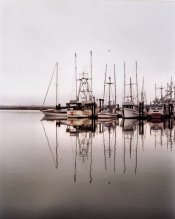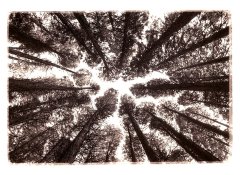Bingo! It was inevitable that eventually someone just had to bring up AA. Talk about stereotypes! But ya also have to recognize that how he did it doesn't necessary equate to how a lot of wannabee clones do it. Mere technique doesn't count. Everyone can read the how-to books; not many can actually sense the light to the same degree. Most go over the top and spoil it. Sure, I've got some prints in that vein. I've also got a lot that aren't. But having come from those mountains, I do have an appreciation for AA's sensitivity to the light n' clouds and so forth that many flatlanders and smog dwellers can't quite understand, cause they've never been absorbed into it, so to speak. So I really do get it. But if a scene in my mind works better taking a totally different approach, let's say, for example, a much more open sky with the sense of scale and atmosphere being accentuated by lightening it instead of darkening ala AA, then that's why I'll do, or even blank it out completely white for sake of graphic effect, much like the old blue sensitive landscape masters did.
My very favorite picture of all time of the El Capitan monolith in Yosemite was not any of the famous dark-sky ones by AA, but a totally blank sky version taken by Edweard Muybridge. It has an overriding sense of scale and monumentality bound to its sheer graphic simplicity, nearly white on white. My second favorite might be my own, taken on edge during a snowstorm from atop a high ice cone, which I chiseled off the top of with my ice axe for sake of my 4X5 tripod, itself with a white sky, but more silky and subtle in atmosphere, and silvery with respect to the granite, than Muybridge's version from down below. But I did bag the same impression of monumentality and sheer scale. I was there with my nephew when he was surveying his next intended climbing route up the Dawn Wall directly overhead, only the third ascent of that extreme route ever. He discovered that Warren Harding's claim to have climbed it on only a pint of water a day, over twenty days, was true - there were still dozens of wine bottles left stuffed in big cracks along the way!
But now that I brought up smog, and earlier made the statement that I've never seen a boring sky.... well, for months on end last year our skies were so filled with smoke as to obscure any kind of cloud detail. But there was an utterly magical property to it almost like an amber Godfather movie effect, yet with soft veiling yellow-brown haze doing amazing things with hues both natural and manmade, in a manner no mere camera filter could have done. But the air was just too unhealthy to do much outdoor shooting; and besides, all that fine white and yellowish ash raining down days on end would be terrible for camera equipment. My lungs hurt for weeks afterwards. So ya gotta pick and choose yer battles.













